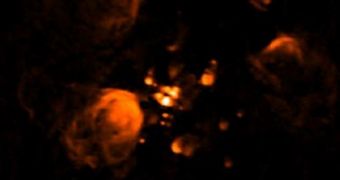An international collaboration of astronomers and astrophysicists was recently able to establish the exact mechanism through which stars at least 10 times more massive than the Sun form. This process has been hotly debated in the scientific community for decades.
The main mystery surrounding the birth of massive stars is related to the large amount of ultraviolet radiations these bodies produce in the earliest stages of their lives. This radiation heats up the gas in the nebulae from which the stars formed, and researchers have long since been wondering why the gas does not simply scatter outwards under this enormous pressure.
Recent observations conducted with the Jansky Very Large Array (VLA), in New Mexico, have revealed that dense filamentary structures develop in the original gas clouds from which stars collapse. These formations absorb a vast amount of ultraviolet radiation, making the parent nebulae flicker like candles as seen from Earth.
The investigation included astronomers from the Harvard-Smithsonian Center for Astrophysics, the American Museum of Natural History, the University of Zürich, Agnes Scott College, the National Radio Astronomy Observatory, the European Southern Observatory, and the University of Heidelberg.
The existence of dense filamentary structures inside parent nebulae has been proposed some time ago, but scientists were unable until now to establish whether or not these formations actually exist. Details of the research appear in a recent issue of the esteemed Astrophysical Journal Letters.
“Massive stars dominate the lives of their host galaxies through their ionizing radiation and supernova explosions. All the elements heavier than iron were formed in the supernova explosions occurring at the ends of their lives, so without them, life on Earth would be very different,” says Mordecai-Mark Mac Low, a curator with the ANMH Department of Astrophysics, and an author of the AJL paper.
A series of recent computer models has revealed that the hydrogen gas around massive stars is not evenly absorbed into the objects, but rather forms filaments that wisp their way to the stellar surface. These structures are formed through localized gravitational collapses, due to the extremely high amounts of gas present at those locations.
VLA observations revealed that the filaments are able to absorb extreme amounts of ultraviolet radiations, meaning that the surrounding gas in the nebula – which did not collapse locally – is shielded from the radiations, and does not get vented out into interstellar space.

 14 DAY TRIAL //
14 DAY TRIAL //